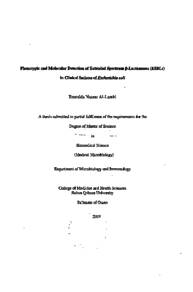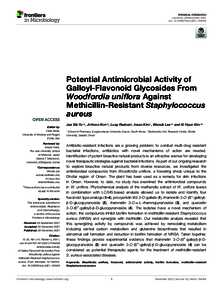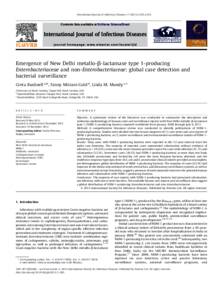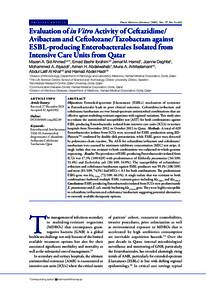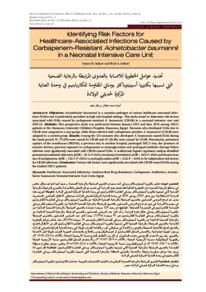Document
Phenotypic and molecular detection of extended spectrum B-lactamases (ESBLs) in clinical isolates of Escherichia coli
Publisher
Sultan Qaboos University
Gregorian
2009
Language
English
Subject
English abstract
ESBLs are plasmid mediated enzymes capable of hydrolyzing the B-lactam antibiotics including penicillins and broad spectrum cephalosporins. ESBL dissemination has been reported worldwide. Since the detection of the first TEM-1 plasmid-encoded enzyme in Escherichia coli, more than 200 types of ESBLS have been detected worldwide. Specific ESBL variant can be distinct to a certain country or a region. The aim of this study was to detect ESBLs in clinical isolates of E. coli and to characterize these as TEM or SHV using PCR. A total of ninety eight isolates of E. coli recovered from various clinical samples of patients attending Sultan Qaboos University Hospital were collected during a 4 month (Nov-Feb) period in 2008. Isolates were screened for ESBL production using the Clinical laboratory Standards Institute (CLSI) recommended disk diffusion method. The screen positive isolates were subjected to phenotypic confirmatory test as recommended by CLSI. Characterization of the ESBLs produced by the isolates as TEM and SHV was undertaken using PCR and specific primers. A total of 17 (17.3%) isolates were confirmed to be ESBL producers by the phenotypic confirmatory test. In five of these 17 isolates the ESBLs could be confirmed as TEM. None of the isolates harbored the SHV type of ESBL, A large majority of ESBL producers were isolated from urine (70.6%). A larger percentage of isolates recovered from hospitalized patients (-18.5 %) were positive for ESBL as compared to the isolates recovered from outdoor patients (-15.2 %). All the isolates were susceptible to imipenem. Resistance to gentamicin (53% versus 7.4%) and ciprofloxacin (88.2% versus18.5%) was more common among ESBL positive isolates than in ESBL negative isolates. Cefotaxime proved to be a better substrate than ceftazidime since the former detected 17 while the later detected 15 isolates as ESBL producers.
Member of
Resource URL
Arabic abstract
ESBLs عبارة عن انزيمات تنتقل بواسطة الأنزيمات قادرة على تفكيك المضادات الحيوية من نوع البيتالاكتام بما فيهم البنيسلين، نطاق واسع من السيفالوسبورينات. انتشار ESBL مسجل في جميع انحاء العالم. منذ اكتشاف اول انزيم 1-TEM المشفر في البلاسميد في بكتيريا الى Escherichia coli ، تم اكتشاف اكثر من 200 نوع من انزيمات ESBLs في جميع انحاء العالم. بدائل ESBLs ممكن ان تكون متميزة لبلد معين أو منطقة . الهدف من هذه الدراسة هو الكشف عن ESBLs في بكتيريا الى E. coli المستخلص من مختلف العينات السريرية ولوصف هذه الأنزيمات ب TEM او SHV باسخدام تفاعلات سلسلة البلمرة(PCR) .الطريقة: تم جمع ثمانية وتسعين E. coli المسخلصة من عينات المرضى الذين يحضرون مستشفى جامعة السلطان قابوس خلال اربعة اشهر (نوفمبر- فبراير) العام 2008. تم فحص العينات الانتاجها لانزيم ESBL باستخدام طريقة انتشار القرص disk) diffusion method) على النحو الذي يوصي به CLSI. العينات التي أظهرت نتائج ايجابية لانتاج الانزيم تم عرضها لأختبار النمط الظاهري المؤكد كما توصی به CLSI. تم وصف المESBL ب TEM او SHV بواسطة تفاعلات سلسلة البلمرة وباستخدام primers خاصة. النتائج: تم تأكيد 17 (17. 3 %) من عينات ال E. coli لانتاجها للبESBL باستخدام اختبار النط الظاهري. 5 عينات من المجموع الإجمالي 17تم وصفها بTEM . لم تظهر اي عينة حملها الصفة الSHV. اغلبية ال E. coli المنتجة للESBL تم عزلها من البول (70. 6 %). النسبة الأكبر من ال .E coliالمنتجة للESBL تم عزلها من المرضى المرقدين بالمستشفی (یہ 18. 5 %) مقارنة بالمرضى المراجعين للمسشفی (- 15. 2 %). جميع عينات إل E. coli أظهرت تاثرهاب المضاد الحيوي ايميبينم (imipenem). المقاومة اتجاه المضاد الحيوي جينتميسين (gentamicin) ( % 53 مقابل 7. 4 %) وكذلك اتجاه المضاد سیبرفلوكساسين ciprofloxacin). (88. 2 % مقابل 18. 5 %) كان أكثر شيوعا بين العينات المنتجة للESBL من نظيراتها الغير منتجة لهذا الإنزيم المضاد الحيوي كيفوتاكسيم (Cefotaxime) اثبت انه المؤشر الأفضل في الكشف عن ال ESBL مقارنة بالمضاد الحيوي کيفتازیدیم (Ceftazidime)، حيث كشف الأول عن 17 عينة منتجة للمESBI في حين كشف الأخير عن 15 عينة.
Category
Theses and Dissertations

